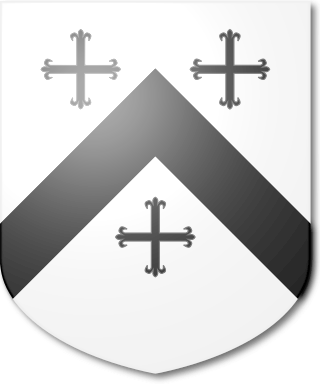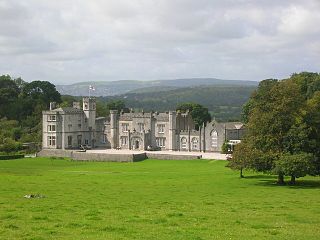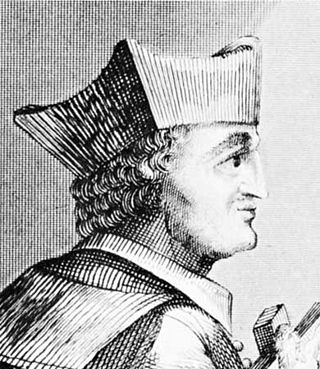
The Hodges Baronetcy, of Middlesex, was a title in the Baronetage of England. It was created on 31 March 1697 for William Hodges, Member of Parliament for Mitchell. [1] The title became extinct on the death of the second Baronet in 1722.

The Hodges Baronetcy, of Middlesex, was a title in the Baronetage of England. It was created on 31 March 1697 for William Hodges, Member of Parliament for Mitchell. [1] The title became extinct on the death of the second Baronet in 1722.
There have been three baronetcies created for members of the Clerke family. One creation is extant as of 2008.
The Ayloffe Baronetcy, of Braxted Magna in the County of Essex, was a title in the Baronetage of England. It was created on 25 November 1611 for Sir William Ayloffe, subsequently Member of Parliament for Stockbridge. The second Baronet was High Sheriff of Essex and supported the Royalist cause in the Civil War. The third Baronet was an officer in the Royalist army during the Civil War. The fourth Baronet was a London merchant. The fifth Baronet was Rector of Stanford Rivers in Essex from 1707 until 1730. The sixth Baronet was an antiquary. The title became extinct on his death 19 April 1781.

There have been two baronetcies created for persons with the surname Alston, both in the Baronetage of England. Both creations are extinct.

There have been nine baronetcies created for persons with the surname Anderson, four in the Baronetage of England, one in the Baronetage of Great Britain and four in the Baronetage of the United Kingdom. All creations are extinct.

There have been six baronetcies created for persons with the surname Middleton, four in the Baronetage of England, one in the Baronetage of Great Britain and one in the Baronetage of the United Kingdom. One creation is extant as of 2008.

The Trelawny, later Salusbury-Trelawny Baronetcy, of Trelawny in the County of Cornwall, is a title in the Baronetage of England. It was created on 1 July 1628 for John Trelawny of Trelawny in the parish of Pelynt in Cornwall. The family derived much of their political power from their patronage of the nearby pocket borough of East Looe. The second Baronet sat as Member of Parliament for East Looe, Cornwall and Liskeard. The third Baronet was a clergyman and one of the Seven Bishops imprisoned by James II. The fourth Baronet represented West Looe, Liskeard and East Looe in the House of Commons. The fifth Baronet was Member of Parliament for East Looe. The sixth Baronet sat as Member of Parliament for West Looe and served as Governor of Jamaica. The eighth Baronet was Member of Parliament for East Cornwall 1832–1837 and Lord-Lieutenant of Cornwall. In 1802 he assumed the additional surname of Salusbury. The ninth Baronet represented Tavistock and East Cornwall in Parliament.
There have been nine baronetcies created for persons with the surname Moore, two in the Baronetage of England, one in the Baronetage of Ireland, two in the Baronetage of Great Britain and four in the Baronetage of the United Kingdom. As of 2014 two creations are extant and one is considered dormant.
There have been two baronetcies created for persons with the surname Gray, one in the Baronetage of Nova Scotia and one in the Baronetage of the United Kingdom. One creation is extant as of 2007.
There have been four baronetcies created for members of the Thorold family of Lincolnshire, two in the Baronetage of England and two in the Baronetage of Great Britain. As of 2014 one creation is extant.

There have been two baronetcies created for persons with the surname Goring, both in the Baronetage of England. The second creation came into the family through a special remainder in the patent creating the baronetcy. Only the latter creation is extant as of 2008.
There have been three baronetcies created for personswith the surname Elphinstone, two in the Baronetage of Nova Scotia and one in the Baronetage of the United Kingdom. As of 2008 two of the creations are extant while one is dormant.
The Nicolson baronets refer to one of four baronetcies created for persons with the surname Nicolson, all in the Baronetage of Nova Scotia. Two of the creations remain extant as of 2008.

There have been three baronetcies created for members of the Sedley family of Kent, all in the Baronetage of England. All three creations are extinct.
The Wyvill Baronetcy, of Constable Burton in the County of York, was a title in the Baronetage of England. It was created on 25 November 1611 for Marmaduke Wyvill, the former Member of Parliament for Richmond. The fifth and sixth Baronets also represented Richmond in the House of Commons. The title became dormant on the death of the seventh Baronet in 1774.

The Petre Baronetcy, of Cranham Hall in the County of Essex, was a title in the Baronetage of England. It was created in circa 1642 for Francis Petre. The third Baronet was a Jesuit and close adviser to King James II. The title became extinct on the death of the fifth Baronet in 1722.
The Walter Baronetcy, of Saresden in the County of Oxford, was a title in the Baronetage of England. It was created on 16 August 1641 for William Walter, previously Member of Parliament for Weobly. The third Baronet sat as member of parliament for Appleby and Oxford. The title became extinct on the death of the fourth Baronet in 1731.

The Dolben Baronetcy, of Finedon in the County of Northamptonshire, was a title in the Baronetage of England. It was created on 1 April 1704 for Gilbert Dolben, son of John Dolben, Archbishop of York. Gilbert was judge of the Court of Common Pleas (Ireland) and MP for Ripon, Peterborough and Yarmouth, Isle of Wight. The 3rd Baronet was an MP for Oxford University and Northamptonshire, and was an avid campaigner for abolition of the slave trade. The title became extinct on the death of Sir John English Dolben, the 4th Baronet, in 1837. William Harcourt Isham Mackworth (1806–1872), a younger son of Sir Digby Mackworth, the 3rd Baronet, took the additional surname Dolben after he married Frances, the heiress of the 4th Baronet.
The Davers Baronetcy, of Rougham in the County of Suffolk, was a title in the Baronetage of England. It was created on 12 May 1682 for Robert Davers, who had made a great fortune in Barbados before acquiring the Rougham estate in Suffolk. The second and fourth Baronets represented Bury St Edmunds and Suffolk in Parliament. The sixth Baronet sat as Member of Parliament for Weymouth and Bury St Edmunds. Despite having an alleged nine illegitimate children, the 6th Baronet left his estates to his nephew, Frederick Hervey, 1st Marquess of Bristol, and his baronetcy became extinct.
There have been two baronetcies created for persons with the surname Meredyth, both in the Baronetage of Ireland. Both are extinct.
There have been two baronetcies created for persons with the surname Houston, one in the Baronetage of Nova Scotia and one in the Baronetage of the United Kingdom, both extinct.